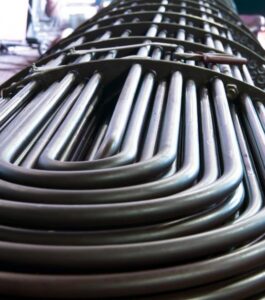Top 10 Cleaning and Inspection Challenges: No. 6
U-Tube (Hairpin) Exchanger Cleaning
Based on an extensive survey of 500 refinery operators, U-Tube (Hairpin) heat exchanger cleaning ranks sixth among the most prevalent cleaning challenges in the refining industry. In this in-depth discussion, we will explore the issues around this type of fouling and solutions to restore efficiency and maximise productivity.
Introduction
Hairpin heat exchangers, also known as U-Tube or multi-tube heat exchangers, are widely used in heavy industries. These efficient heat exchangers, in the form of G-fin or double-pipe configurations, offer exceptional performance.
However, when it comes to cleaning these double-pipe or multi-tube heat exchangers, traditional water jetting and chemical cleaning techniques pose a challenge. With hundreds of small bore tubes, including straight and curved radii, hairpin heat exchangers tend to accumulate deposits.
Moreover, the narrow 6mm spacing of the square pitch on the shell side further intensifies the cleaning process. In this blog post, we will delve into the intricacies of cleaning hairpin heat exchangers, addressing the unique challenges and exploring effective strategies to maintain their optimal performance.
The Challenge
Hairpin heat exchanger cleaning presents unique challenges when it comes to maintaining production throughput and heat transfer efficiency. Traditional methods like high pressure water jetting struggle to effectively clean hard-to-reach areas, such as the shell side and hairpin bends. Moreover, current technologies fail to adequately remove tenacious carbon and coke fouling, both within the “U” bends and on the external shell side tube surfaces. Chemical cleaning, though an option, is not ideal as it doesn’t address blockages within hairpin heat exchangers and poses environmental concerns during waste disposal.
When it comes to unblocking and cleaning hairpin heat exchangers, manual and remote high-pressure water jetting have limitations. Not only can these methods be slow, but they also pose risks due to hydraulic recoil on both rigid and flexible water jetting lances. Additionally, neither flexible nor rigid high-pressure water lances can effectively negotiate hairpin bends or thoroughly clean the external shell side tube surface of square pitch shell and tube exchangers.
To ensure optimal performance and productivity, it’s crucial to employ specialized techniques for hairpin heat exchanger cleaning. These techniques address the unique challenges associated with scale, blockages, and fouling, enabling improved heat transfer efficiency and production throughput.
U-Tube Heat Exchanger Cleaning Solutions for Tube and Shell Side
DarTT and Shell Jett™ clean both the U-tube and external shell side of straight and hairpin shell and tube heat exchangers simultaneously. TubeTech’s enhanced tube polishing system ensures IRIS standard cleanliness consistently.
Conclusion
TubeTech™, renowned experts in heat exchanger cleaning, provide superior solutions for the cleaning of U-Tube (Hairpin) heat exchangers. With our extensive experience and innovative approach, we have perfected systems to overcome the challenges of cleaning titanium, stainless steel, and other metal tubes. Our expertise extends to refinery shutdowns and petrochemical turnarounds, ensuring efficient cleaning of straight, hairpin, and coiled heat transfer plants.

